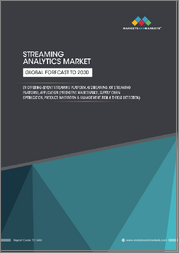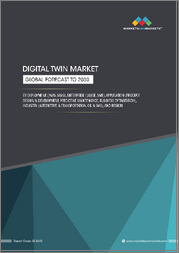
|
시장보고서
상품코드
1804253
세계의 예지보전 시장 : 컴포넌트별, 배포 형태별, 기술별, 조직 규모별, 산업별, 지역별 - 시장 규모, 산업 역학, 기회 분석, 예측(2025-2033년)Global Predictive Maintenance Market: Component, Deployment Mode, Technology, Organization Size, Industry, Region-Market Size, Industry Dynamics, Opportunity Analysis and Forecast for 2025-2033 |
||||||
2024년 예지보전 시장은 장비의 다운타임을 최소화하고 다양한 산업 분야에서 운영 효율을 높이기 위한 절박한 수요에 힘입어 비약적인 성장을 이룰 것으로 예측됩니다. 2024년 시장 규모는 89억 6,000만 달러였으나 2033년에는 910억 4,000만 달러에 달할 것으로 예측됩니다. 이는 2025-2033년의 예측 기간 중 29.4%의 연평균 복합 성장률(CAGR)을 보일 것으로 예측됩니다. 이러한 급격한 확대는 인공지능(AI), 사물인터넷(IoT) 등 첨단 기술의 통합에 힘입은 바 크며, 이를 통해 기업은 데이터베이스 유지보수 전략을 채택할 수 있게 되었습니다.
북미는 강력한 산업 기반, 첨단 기술의 조기 도입, 디지털 전환 구상에 대한 막대한 투자로 인해 예지보전 시장에서 지배적인 위치를 유지하고 있습니다. 제조, 에너지, 헬스케어 등 주요 부문은 생산성을 높이고 운영 리스크를 줄이기 위해 예지보전 솔루션을 채택하고 있습니다. 이 지역은 IBM, Microsoft, General Electric, PTC와 같은 세계적인 대기업을 포함한 주요 솔루션 프로바이더들이 본사와 연구소를 두고 혁신 생태계를 조성하고 있습니다.
주목할 만한 시장 발전
예지보전 시장에서는 여러 유력 기업이 혁신적인 기술과 전략적 구상로 업계 판도를 형성하고 있습니다. Cisco Systems, Inc., General Electric Company, SAP SE, Schneider Electric SE, Siemens 등 주요 기업은 첨단 예지보전 솔루션 개발 및 보급에 기여하는 주요 기업으로 자리매김하고 있습니다. 이들 업계 리더들은 파트너십, M&A, 타사와의 제휴 등 시장에서의 입지를 강화하기 위해 다양한 전략을 적극적으로 추진하고 있습니다.
이러한 전략적 활동의 대표적인 예는 2025년 2월 IBM이 64억 달러에 HashCorp 인수를 완료한 것입니다. 이번 인수는 HashCorp의 기술을 IBM의 레드햇 제품과 통합함으로써 IBM의 멀티 클라우드 기능과 예지보전 포트폴리오를 크게 강화했습니다. 이는 클라우드 인프라를 활용한 확장 가능하고 유연한 예지보전 솔루션을 제공하겠다는 IBM의 약속을 강화한 것입니다.
시장의 역동적인 특성을 더욱 강조하기 위해 C3 AI는 2025년 6월 미국 공군 신속 유지보수 사무소로부터 1,300만 달러의 작업 주문을 수주했습니다. 이번 계약은 C3 AI의 AI 기반 예지보전 시스템을 더 많은 항공기 플랫폼으로 확장하는 것을 목표로 하며, 매우 복잡하고 중요한 환경에서의 보전 능력을 강화하기 위해 인공지능에 대한 의존도가 높아지고 있음을 보여줍니다. 이번 확대는 장비의 신뢰성과 임무의 즉각적인 대응이 가장 중요한 국방 분야에서 예지보전 기술의 전략적 중요성을 강조합니다.
핵심 성장 요인
2024년 예지보전 시장은 전 세계 산업계에 중요한 분야가 될 것이며, 그 주요 원동력은 유지보수 비용을 절감하고 계획되지 않은 다운타임을 최소화해야 한다는 절박한 요구가 될 것입니다. 예기치 못한 장비 고장은 값비싼 수리, 생산 중단, 매출 손실로 이어져 막대한 재정적 손실을 초래할 수 있습니다. 이러한 위험은 각 분야의 이해관계자들에게 잠재적인 문제를 조기에 발견하고 적시에 개입할 수 있는 예지보전 전략을 채택하는 것의 중요성을 강조하고 있습니다.
새로운 기회 동향
2024년 예지보전 시장은 디지털 트윈 기술의 보급에 힘입어 큰 변화의 시기를 맞이하고 있습니다. 디지털 트윈은 이해관계자가 가상 환경에서 장비의 성능을 시뮬레이션, 모니터링, 분석할 수 있도록 하는 물리적 자산의 정교한 가상 복제본입니다. 이 혁신적인 접근 방식을 통해 기업은 실제 자산을 실제 위험이나 혼란에 노출시키지 않고도 다양한 시나리오를 테스트하고, 잠재적인 고장을 예측하고, 유지보수 일정을 최적화할 수 있습니다.
최적화를 가로막는 장벽
2024년에는 데이터 보안과 품질 문제가 예지보전 시장에서 중요한 이슈로 떠오르며, 이해관계자들에게 이러한 시스템의 효율성과 신뢰성에 직접적인 영향을 미칠 것입니다. 예지보전은 산업 장비에 내장된 IoT 장치와 센서가 생성하는 방대한 데이터 수집과 분석에 크게 의존하고 있습니다. 이 데이터의 정확성과 무결성은 매우 중요하며, 만약 이 데이터가 손상되면 잠재적인 고장을 감지하고 유지보수 필요성을 정확하게 예측하는 시스템의 능력이 크게 손상될 수 있습니다. 이러한 데이터를 사이버 위협으로부터 안전하게 보호하고 품질을 유지하는 것은 예지보전 솔루션을 도입하는 조직에게 최우선 과제가 되고 있습니다.
시장 세분화 세부 정보
컴포넌트별로는 통합형 및 독립형 예지보전 솔루션이 시장 점유율의 70% 이상을 차지하며 예지보전 시장을 전반적으로 지배하고 있습니다. 이러한 솔루션은 종합적인 분석을 제공하고 장비의 상태를 실시간으로 모니터링할 수 있도록 함으로써 산업 운영을 근본적으로 변화시켜왔습니다. 고급 데이터 처리와 정교한 알고리즘을 결합하여 기계 상태에 대한 심층적인 인사이트를 제공하고, 잠재적인 고장을 예측하고, 유지보수 활동을 사전에 예약할 수 있도록 합니다.
기술별로는 진동 모니터링 기술이 예지보전 시장의 기본 컴포넌트로 자리매김하고 있으며, 시장 점유율 22.6% 이상을 차지하고 있습니다. 이 기술은 다양한 산업 분야에서 장비 고장의 초기 징후를 감지하는 탁월한 능력으로 높은 평가를 받고 있습니다. 기계에서 발생하는 진동을 지속적으로 측정하고 분석함으로써 진동 모니터링 시스템은 종종 기계 고장에 앞서 발생하는 미묘한 이상을 식별할 수 있습니다.
산업별로는 제조업이 예지보전 시장을 주도하고 있으며, 25.7% 이상의 압도적인 점유율을 차지하고 있습니다. 이러한 장점은 지속적인 운영을 유지하고 비용이 많이 드는 장비의 다운타임을 최소화해야 하는 제조 부문의 중요한 요구 사항을 반영합니다. 정교한 예지보전 툴을 활용하면 제조업체는 방대한 양의 운영 데이터를 분석하여 장비의 성능 저하 징후를 조기에 발견하고 적시에 유지보수 개입 일정을 수립할 수 있습니다.
도입 형태별로는 On-Premise 도입이 예지보전 시장의 지배적인 접근방식으로 시장 점유율 63.6% 이상을 확보하고 있습니다. 이러한 선호는 주로 강화된 데이터 관리와 엄격한 보안 요구사항에 대한 요구가 높아졌기 때문입니다. 다양한 산업 분야의 조직들이 기밀성이 높은 업무 데이터 보호를 최우선 과제로 삼고 있으며, On-Premise 솔루션이 특히 매력적으로 다가오고 있습니다.
부문별 내역
컴포넌트별
- 솔루션
- 통합형
- 독립형
- 서비스
- 매니지드 서비스
- 전문 서비스
전개 형태별
- 클라우드
- 퍼블릭 클라우드
- 프라이빗 클라우드
- 하이브리드 클라우드
- On-Premise
기술별
- 진동 모니터링
- 전기 테스트
- 오일 분석
- 초음파 검출기
- 충격 펄스
- 열/적외선 모니터링
- 광학(카메라) 모니터링
- ML 데이터베이스
- 기타
조직 규모별
- 대기업
- 중소기업
산업별
- 항공우주/방위산업
- 제조업
- 에너지 및 유틸리티
- 석유 및 가스
- 교통
- 창고-물류
- 헬스케어-생명과학
- 자동차
- 해운
- 기타
지역별
- 북미
- 미국
- 캐나다
- 멕시코
- 유럽
- 영국
- 독일
- 프랑스
- 이탈리아
- 스페인
- 폴란드
- 러시아
- 기타
- 아시아태평양
- 중국
- 인도
- 일본
- 한국
- 호주 및 뉴질랜드
- ASEAN
- 말레이시아
- 싱가포르
- 태국
- 인도네시아
- 필리핀
- 베트남
- 기타
- 기타 지역
- 중동 및 아프리카
- 아랍에미리트
- 사우디아라비아
- 남아프리카공화국
- 기타
- 남미
- 아르헨티나
- 브라질
- 기타
주요 시장 진출기업
- Fujitsu Limited
- Hitachi, Ltd.
- Toshiba Corporation
- Mitsubishi Electric Corporation
- Google Llc
- IBM Corporation
- Microsoft Corporation
- Oracle Corporation
- SAP Se
- Software Ag
- Onyx Insight
- Amazon Web Services, Inc.
- SAS Institute
- Hakunamatata Solutions
- 기타
목차
제1장 조사 프레임워크
제2장 조사 방법
제3장 개요 : 세계의 예지보전 시장
제4장 세계의 예지보전 시장 개요
- 업계 밸류체인 분석
- 테크놀러지 개발자
- 인티그레이터
- 서비스 프로바이더
- 최종사용자
- 업계 전망
- 예지보전의 ROI 측정의 개요
- PESTLE 분석
- Porter's Five Forces 분석
- 시장 역학과 동향
- 시장 성장 동향에 대한 COVID-19의 영향 평가
- 시장의 성장과 전망
- 경쟁 대시보드
제5장 세계의 예지보전 시장 분석(컴포넌트별)
- 주요 인사이트
- 시장 규모와 예측, 2020-2033년(100만 달러)
- 솔루션
- 서비스
제6장 세계의 예지보전 시장 분석(배포 형태별)
- 주요 인사이트
- 시장 규모와 예측, 2020-2033년(100만 달러)
- 클라우드
- 온프레미스
제7장 세계의 예지보전 시장 분석(기술별)
- 주요 인사이트
- 시장 규모와 예측, 2020-2033년(100만 달러)
- 진동 감시
- 전기 시험
- 오일 분석
- 초음파 검출기
- 쇼크 펄스
- 열/적외선 모니터링
- 광학(카메라) 감시
- ML 데이터베이스
- 기타
제8장 세계의 예지보전 시장 분석(조직 규모별)
- 주요 인사이트
- 시장 규모와 예측, 2020-2033년(100만 달러)
- 대기업
- 중소기업
제10장 세계의 예지보전 시장 분석(산업별)
- 주요 인사이트
- 시장 규모와 예측, 2020-2033년(100만 달러)
- 항공우주·방위
- 제조업
- 에너지·유틸리티
- 석유 및 가스
- 교통기관
- 창고·물류
- 헬스케어·생명과학
- 자동차
- 선박
- 기타
제11장 세계의 예지보전 시장 분석(지역별)
- 주요 인사이트
- 시장 규모와 예측, 2020-2033년(100만 달러)
- 북미
- 유럽
- 아시아태평양
- 중동 및 아프리카
- 남미
제12장 북미의 예지보전 시장 분석
제13장 유럽의 예지보전 시장 분석
제14장 아시아태평양의 예지보전 시장 분석
제15장 중동 및 아프리카의 예지보전 시장 분석
제16장 남미의 예지보전 시장 분석
제17장 기업 개요
- IBM
- Microsoft Corporation
- SAP
- ABB Ltd.
- Siemens AG
- Schneider Electric
- Hitachi, Ltd.
- Oracle Corporation
- Fujitsu Ltd.
- GE
- Rockwell Automation
- Amazon Web Services, Inc.
- PTC
- Mitsubishi Electric Corporation
- Robert Bosch
- Honeywell
- Onyx Insight
- SAS Institute
- Toshiba Corporation
- Google Llc
- Software Ag
- Hakunamatata Solutions
- 기타
In 2024, the predictive maintenance market is witnessing unparalleled growth fueled by the pressing demand to minimize equipment downtime and boost operational efficiency across various industries. Valued at US$ 8.96 billion in 2024, the market is projected to soar dramatically, reaching an estimated US$ 91.04 billion by 2033. This represents a remarkable compound annual growth rate (CAGR) of 29.4% over the forecast period from 2025 to 2033. The rapid expansion is largely attributed to the integration of advanced technologies such as artificial intelligence (AI) and the Internet of Things (IoT), which empower companies to adopt data-driven maintenance strategies.
North America maintains a dominant position in the predictive maintenance market, bolstered by its strong industrial base, early adoption of cutting-edge technologies, and significant investments in digital transformation initiatives. Key sectors such as manufacturing, energy, and healthcare have embraced predictive maintenance solutions to enhance productivity and reduce operational risks. The region serves as a hub for leading solution providers, including global giants like IBM, Microsoft, General Electric, and PTC, whose headquarters and research centers foster an ecosystem of innovation.
Noteworthy Market Developments
In the predictive maintenance market, several prominent players are shaping the industry landscape with their innovative technologies and strategic initiatives. Leading companies such as Cisco Systems, Inc., General Electric Company, SAP SE, Schneider Electric SE, and Siemens have established themselves as key contributors to the development and deployment of advanced predictive maintenance solutions. These industry leaders are actively pursuing various strategies to strengthen their market positions, including partnerships, mergers and acquisitions, and collaborations with other firms.
A notable example of such strategic activity occurred in February 2025 when IBM completed its acquisition of HashiCorp for US$ 6.4 billion. This acquisition significantly bolstered IBM's multicloud capabilities and predictive maintenance portfolio by integrating HashiCorp's technologies with IBM's Red Hat offerings. The move reinforced IBM's commitment to delivering scalable and flexible predictive maintenance solutions that leverage cloud infrastructure.
Further highlighting the dynamic nature of the market, in June 2025, C3 AI secured a US$ 13 million task order from the U.S. Air Force Rapid Sustainment Office. This contract is intended to expand C3 AI's AI-enabled predictive maintenance system across additional aircraft platforms, demonstrating the increasing reliance on artificial intelligence to enhance maintenance capabilities in highly complex and critical environments. The expansion underscores the strategic importance of predictive maintenance technologies in defense applications, where equipment reliability and mission readiness are paramount.
Core Growth Drivers
In 2024, the predictive maintenance market has become a critical area of focus for industries worldwide, primarily driven by the pressing need to reduce maintenance costs and minimize unplanned downtime. Unexpected equipment failures can have devastating financial consequences, leading to expensive repairs, production halts, and lost revenue. For stakeholders across sectors, these risks underscore the importance of adopting predictive maintenance strategies that enable early detection of potential issues and timely intervention.
Emerging Opportunity Trends
In 2024, the predictive maintenance market is undergoing a significant transformation driven by the widespread adoption of digital twin technology. Digital twins are sophisticated virtual replicas of physical assets that enable stakeholders to simulate, monitor, and analyze the performance of equipment in a virtual environment. This innovative approach allows companies to test various scenarios, predict potential failures, and optimize maintenance schedules without exposing actual assets to real-world risks or disruptions.
Barriers to Optimization
In 2024, data security and quality issues have emerged as significant challenges within the predictive maintenance market, directly impacting the effectiveness and reliability of these systems for stakeholders. Predictive maintenance heavily depends on the collection and analysis of vast amounts of data generated by IoT devices and sensors embedded in industrial equipment. The accuracy and integrity of this data are crucial, as any compromise can severely undermine the system's ability to detect potential failures and predict maintenance needs accurately. Ensuring robust protection of this data from cyber threats, as well as maintaining its quality, has become a top priority for organizations adopting predictive maintenance solutions.
Detailed Market Segmentation
By Component, integrated and standalone predictive maintenance solutions collectively dominate the predictive maintenance market, capturing over 70% of the market share. These solutions have fundamentally transformed industrial operations by providing comprehensive analytics and enabling real-time monitoring of equipment health. By combining advanced data processing with sophisticated algorithms, these systems allow organizations to gain deep insights into the condition of their machinery, predict potential failures, and schedule maintenance activities proactively.
By Technology, vibration monitoring technology has established itself as a fundamental component of the predictive maintenance market, commanding over 22.6% of the market share. This technology is highly valued for its exceptional ability to detect early signs of equipment faults across a wide range of industrial applications. By continuously measuring and analyzing the vibrations produced by machinery, vibration monitoring systems can identify subtle anomalies that often precede mechanical failures.
Based on industry, manufacturers are leading the predictive maintenance market, holding a commanding share of over 25.7%, largely due to their strategic adoption of advanced monitoring technologies. This dominance reflects the manufacturing sector's critical need to maintain continuous operations and minimize costly equipment downtime. By leveraging sophisticated predictive maintenance tools, manufacturers are able to analyze vast amounts of operational data, detect early signs of equipment degradation, and schedule timely maintenance interventions.
By Deployment, on-premise deployments have become the dominant approach in the predictive maintenance market, securing over 63.6% of the market share. This preference is primarily due to the growing need for enhanced data control and stringent security requirements. Organizations across various industries are increasingly prioritizing the protection of sensitive operational data, which makes on-premise solutions particularly attractive.
Segment Breakdown
By Component:
- Solutions
- Integrated
- Standalone
- Services
- Managed Services
- Professional Services
By Deployment Mode:
- Cloud
- Public Cloud
- Private Cloud
- Hybrid Cloud
- On-Premises
By Technology:
- Vibration Monitoring
- Electrical Testing
- Oil Analysis
- Ultrasonic Detectors
- Shock Pulse
- Thermal/Infrared Monitoring
- Optical (cameras) Monitoring
- ML Database
- Others
By Organization Size:
- Large Enterprises
- Small and Medium-Sized Enterprises
By Industry:
- Aerospace and Defense
- Manufacturing
- Energy and Utilities
- Oil & Gas
- Transportation
- Warehouse & Logistics
- Healthcare and Lifesciences
- Automotive
- Marine/ Shipping
- Others
By Region:
- North America
- The U.S.
- Canada
- Mexico
- Europe
- The UK
- Germany
- France
- Italy
- Spain
- Poland
- Russia
- Rest of Europe
- Asia Pacific
- China
- India
- Japan
- South Korea
- Australia & New Zealand
- ASEAN
- Malaysia
- Singapore
- Thailand
- Indonesia
- Philippines
- Vietnam
- Rest of ASEAN
- Rest of Asia Pacific
- Middle East & Africa
- UAE
- Saudi Arabia
- South Africa
- Rest of MEA
- South America
- Argentina
- Brazil
- Rest of South America
Leading Market Participants
- Fujitsu Limited
- Hitachi, Ltd.
- Toshiba Corporation
- Mitsubishi Electric Corporation
- Google Llc
- IBM Corporation
- Microsoft Corporation
- Oracle Corporation
- SAP Se
- Software Ag
- Onyx Insight
- Amazon Web Services, Inc.
- SAS Institute
- Hakunamatata Solutions
- Other Prominent Players
Table of Content
Chapter 1. Research Framework
- 1.1 Research Objective
- 1.2 Product Overview
- 1.3 Market Segmentation
Chapter 2. Research Methodology
- 2.1 Qualitative Research
- 2.1.1 Primary & Secondary Sources
- 2.2 Quantitative Research
- 2.2.1 Primary & Secondary Sources
- 2.3 Breakdown of Primary Research Respondents, By Region
- 2.4 Assumption for the Study
- 2.5 Market Size Estimation
- 2.6. Data Triangulation
Chapter 3. Executive Summary: Global Predictive Maintenance Market
Chapter 4. Global Predictive Maintenance Market Overview
- 4.1. Industry Value Chain Analysis
- 4.1.1. Technology Developer
- 4.1.2. Integrator
- 4.1.3. Service Provider
- 4.1.4. End User
- 4.2. Industry Outlook
- 4.2.1. Overview of Measuring the ROI of Predictive Maintenance
- 4.3. PESTLE Analysis
- 4.4. Porter's Five Forces Analysis
- 4.4.1. Bargaining Power of Suppliers
- 4.4.2. Bargaining Power of Buyers
- 4.4.3. Threat of Substitutes
- 4.4.4. Threat of New Entrants
- 4.4.5. Degree of Competition
- 4.5. Market Dynamics and Trends
- 4.5.1. Growth Drivers
- 4.5.2. Restraints
- 4.5.3. Opportunities
- 4.5.4. Key Trends
- 4.6. Covid-19 Impact Assessment on Market Growth Trend
- 4.7. Market Growth and Outlook
- 4.7.1. Market Revenue Estimates and Forecast (US$ Mn), 2020-2033
- 4.8. Competition Dashboard
- 4.8.1. Market Concentration Rate
- 4.8.2. Company Market Share Analysis (Value %), 2024
- 4.8.3. Competitor Mapping
Chapter 5. Global Predictive Maintenance Market Analysis, By Component
- 5.1. Key Insights
- 5.2. Market Size and Forecast, 2020-2033 (US$ Mn)
- 5.2.1. Solutions
- 5.2.1.1. Integrated
- 5.2.1.2. Standalone
- 5.2.2. Services
- 5.2.2.1. Managed Services
- 5.2.2.2. Professional Services
- 5.2.1. Solutions
Chapter 6. Global Predictive Maintenance Market Analysis, By Deployment Mode
- 6.1. Key Insights
- 6.2. Market Size and Forecast, 2020-2033 (US$ Mn)
- 6.2.1. Cloud
- 6.2.1.1. Public Cloud
- 6.2.1.2. Private Cloud
- 6.2.1.3. Hybrid Cloud
- 6.2.5. On-Premises
- 6.2.1. Cloud
Chapter 7. Global Predictive Maintenance Market Analysis, By Technology
- 7.1. Key Insights
- 7.2. Market Size and Forecast, 2020-2033 (US$ Mn)
- 7.2.1. Vibration Monitoring
- 7.2.2. Electrical Testing
- 7.2.3. Oil Analysis
- 7.2.4. Ultrasonic Detectors
- 7.2.5. Shock Pulse
- 7.2.6. Thermal/Infrared Monitoring
- 7.2.7. Optical (cameras) Monitoring
- 7.2.8. ML Database
- 7.2.9. Others
Chapter 8. Global Predictive Maintenance Market Analysis, By Organization Size
- 8.1. Key Insights
- 8.2. Market Size and Forecast, 2020-2033 (US$ Mn)
- 8.2.1. Large Enterprises
- 8.2.2. Small and Medium-Sized Enterprises
Chapter 10. Global Predictive Maintenance Market Analysis, By Industry
- 10.1. Key Insights
- 10.2. Market Size and Forecast, 2020-2033 (US$ Mn)
- 10.2.1. Aerospace and Defense
- 10.2.2. Manufacturing
- 10.2.3. Energy and Utilities
- 10.2.4. Oil & Gas
- 10.2.5. Transportation
- 10.2.6. Warehouse & Logistics
- 10.2.7. Healthcare and Lifesciences
- 10.2.8. Automotive
- 10.2.9. Marine/ Shipping
- 10.2.10. Others
Chapter 11. Global Predictive Maintenance Market Analysis, By Region
- 11.1. Key Insights
- 11.2. Market Size and Forecast, 2020-2033 (US$ Mn)
- 11.2.1. North America
- 11.2.1.1. The U.S.
- 11.2.1.2. Canada
- 11.2.1.3. Mexico
- 11.2.2. Europe
- 11.2.2.1. The UK
- 11.2.2.2. Germany
- 11.2.2.3. France
- 11.2.2.4. Spain
- 11.2.2.5. Italy
- 11.2.2.6. Russia
- 11.2.2.7. Poland
- 11.2.2.8. Rest of Europe
- 11.2.3. Asia Pacific
- 11.2.3.1. China
- 11.2.3.2. India
- 11.2.3.3. Japan
- 11.2.3.4. South Korea
- 11.2.3.5. Australia & New Zealand
- 11.2.3.6. ASEAN
- 11.2.3.7. Rest of Asia Pacific
- 11.2.4. Middle East & Africa
- 11.2.4.1. UAE
- 11.2.4.2. Saudi Arabia
- 11.2.4.3. South Africa
- 11.2.4.4. Rest of MEA
- 11.2.5. South America
- 11.2.5.1. Argentina
- 11.2.5.2. Brazil
- 11.2.5.3. Rest of South America
- 11.2.1. North America
Chapter 12. North America Predictive Maintenance Market Analysis
- 12.1. Key Insights
- 12.2. Market Size and Forecast, 2020-2033 (US$ Mn)
- 12.2.1. By Component
- 12.2.2. By Deployment Mode
- 12.2.3. By Technology
- 12.2.4. By Organization Size
- 12.2.5. By Industry
- 12.2.6. By Country
Chapter 13. Europe Predictive Maintenance Market Analysis
- 13.1. Key Insights
- 13.2. Market Size and Forecast, 2020-2033 (US$ Mn)
- 13.2.1. By Component
- 13.2.2. By Deployment Mode
- 13.2.3. By Technology
- 13.2.4. By Organization Size
- 13.2.5. By Industry
- 13.2.6. By Country
Chapter 14. Asia Pacific Predictive Maintenance Market Analysis
- 14.1. Key Insights
- 14.2. Market Size and Forecast, 2020-2033 (US$ Mn)
- 14.2.1. By Component
- 14.2.2. By Deployment Mode
- 14.2.3. By Technology
- 14.2.4. By Organization Size
- 14.2.5. By Industry
- 14.2.6. By Country
Chapter 15. Middle East & Africa Predictive Maintenance Market Analysis
- 15.1. Key Insights
- 15.2. Market Size and Forecast, 2020-2033 (US$ Mn)
- 15.2.1. By Component
- 15.2.2. By Deployment Mode
- 15.2.3. By Technology
- 15.2.4. By Organization Size
- 15.2.5. By Industry
- 15.2.6. By Country
Chapter 16. South America Predictive Maintenance Market Analysis
- 16.1. Key Insights
- 16.2. Market Size and Forecast, 2020-2033 (US$ Mn)
- 16.2.1. By Component
- 16.2.2. By Deployment Mode
- 16.2.3. By Technology
- 16.2.4. By Organization Size
- 16.2.5. By Industry
- 16.2.6. By Country
Chapter 17. Company Profile (Company Overview, Financial Matrix, Key Product landscape, Key Personnel, Key Competitors, Contact Address, and Business Strategy Outlook)
- 17.1. IBM
- 17.2. Microsoft Corporation
- 17.3. SAP
- 17.4. ABB Ltd.
- 17.5. Siemens AG
- 17.6. Schneider Electric
- 17.7. Hitachi, Ltd.
- 17.8. Oracle Corporation
- 17.9. Fujitsu Ltd.
- 17.10. GE
- 17.11. Rockwell Automation
- 17.12. Amazon Web Services, Inc.
- 17.13. PTC
- 17.14. Mitsubishi Electric Corporation
- 17.15. Robert Bosch
- 17.16. Honeywell
- 17.17. Onyx Insight
- 17.18. SAS Institute
- 17.19. Toshiba Corporation
- 17.20. Google Llc
- 17.21. Software Ag
- 17.22. Hakunamatata Solutions
- 17.23. Other Prominent Players



















